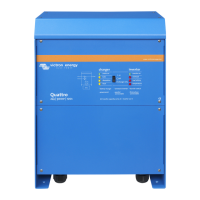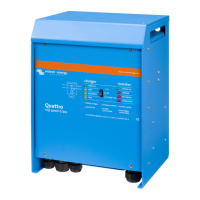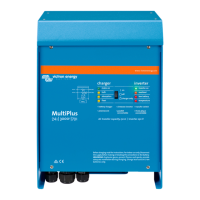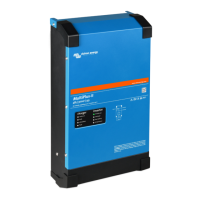14
3. Operation
3.1 “On / stand by / charger only” switch
When the switch is switched to “on”, full device operation is initiated.
The inverter will turn on, and the “inverter on” LED will light.
120VAC applied to L1-1 or L1-2 (see fig 1) will be switched through to the AC
output connection. The inverter is switched off, the “mains on” LED will light
and charger operation will be initiated. Depending on the applicable charging
mode at that time, the “bulk”, “absorption” or “float” LED will light.
If the voltage on both AC-in connections is rejected, the inverter will be
switched on.
If the switch is set to “charger only”, the inverter will not turn on in the event of
AC supply failure. Thus the batteries will not be discharged by the inverter.
3.2 Remote control
Remote control is possible with a simple 3-way switch or with a Multi Control
panel.
The Multi Control panel has a simple rotary knob with which the maximum
current of the AC-in-2 input can be set: see PowerControl and PowerAssist in
Section 2.
3.3 Equalisation and forced absorption
3.3.1 Equalisation
Traction batteries require regular additional charging. In the equalisation
mode, the Quattro will charge with increased voltage for one hour (1V above
the absorption voltage for a 12V battery, 2V for a 24V battery). The charging
current is then limited to 1/4 of the set value. The “bulk” and “absorption”
LEDs flash intermittently.
Equalisation mode supplies a higher charging voltage than most DC consuming
devices can cope with. These devices must be disconnected before additional
charging takes place.
3.3.2 Forced absorption
Under certain circumstances, it can be desirable to charge the battery for a
fixed time at absorption voltage level. In Forced Absorption mode, the Quattro
will charge at the normal absorption voltage level during the set maximum
absorption time. The “absorption” LED lights.
3.3.3 Activating equalisation or forced absorption
The Compact can be put into both these states from the remote panel as well
as with the front panel switch, provided that all switches (on the unit, and
possibly a remote switch or the switch on the Multi Control panel) are set to
“on”.

